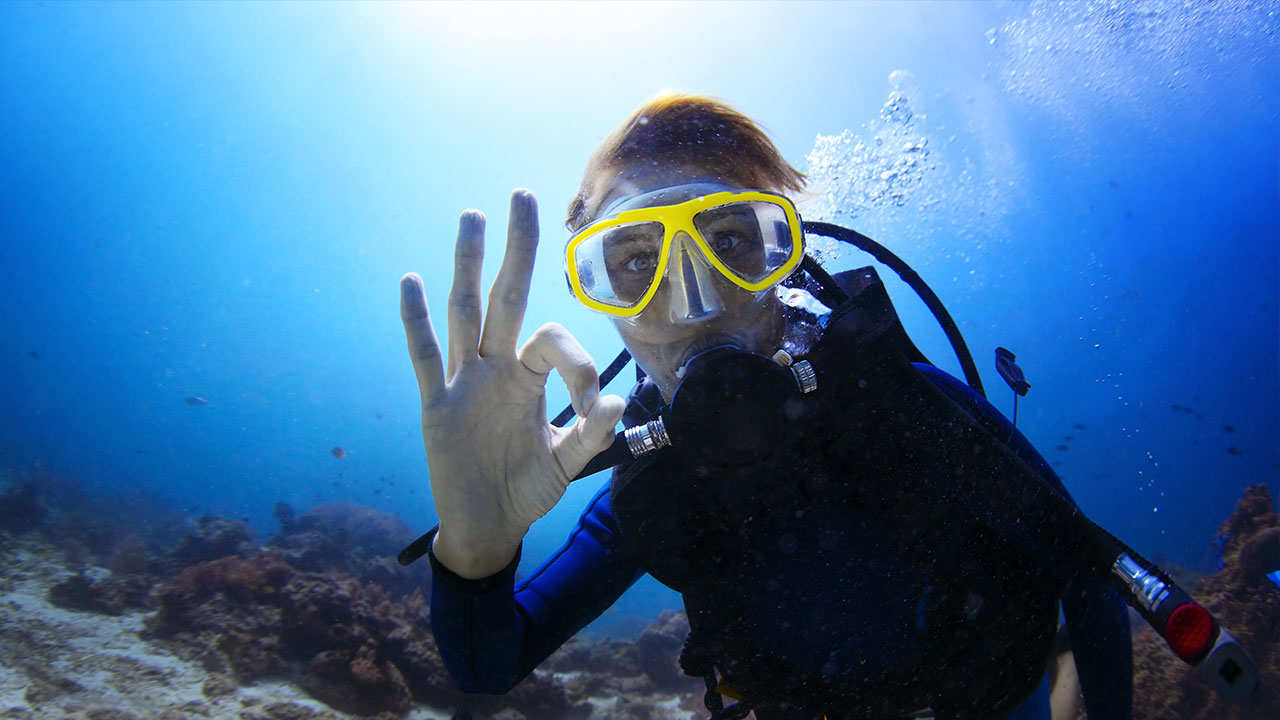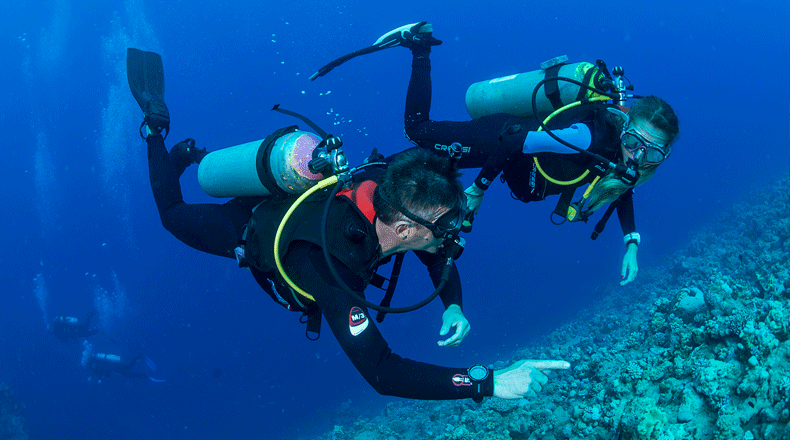Heat Loss and Hypothermia When Diving

Thermal challenges are among the most common issues that many divers encounter during or in between the dives. The reason for this is that our core temperatures have to stay within a certain, narrow range for our bodies to function properly. Although, getting a bit too hot from waiting in the sunshine while wearing a wetsuit or starting to shiver ever so slightly when underwater may seem insignificant, ignoring these signals can lead to serious health problems. Hypothermia, hyperthermia and heat stroke are some of the heat challenges that can result from prolonged exposure to extreme temperatures. In this particular article we are going to focus on hypothermia, so read on, if you want to learn how to prevent, recognize and deal with it.
By definition, hypothermia is the condition in which the core temperature drops below that, required for normal metabolism and body functions. When the body loses heat faster than it can produce heat, hypothermia is said to set in.
The first thing you need to do in order to be able to deal with thermal challenges and hypothermia in particular is understand how the heat transfer works.
There are four ways in which the heat energy can be transferred:
- Conduction - the transfer of heat between two surfaces that are in direct contact. The heat flows from the warmer object to the cooler one, until they are both the same temperature. Solids are better conductors than liquids and liquids are better conductors than gases. As you probably know, water conducts heat about 25 times faster than air, this is why we can get cold even in seemingly warm water.
- Convection - heat transfer between liquids and gasses during which warmer areas of a liquid or gas rise to cooler areas in that liquid or gas. Cooler liquid or gas then takes the place of the warmer areas which have risen higher. This process is ongoing, which means that as the diver’s body heats the water around it, this warm layer moves away to be replaced with cooler water that the body must also warm.
- Radiation - the process by which a warm body emanates heat energy into its environment without any contact between the heat source and the heated object.
- Evaporation - the physical reaction of a liquid turning into a gas with the help of heat energy. For instance, if the moisture is present on the skin, it will evaporate, using heat from the body.
In the context of diving and hypothermia, radiation is basically irrelevant; so is evaporation, unless you're wearing a still-wet wetsuit between the dives. lt’s conduction and convection that we primarily have to worry about. Upon immersion, a diver begins losing heat via conduction. The rate of loss is proportional to the temperature difference between the points of contact and depends on the type of exposure protection used. Then the diver faces convective heat loss due to the movement of water around him/her. In fact, convective heat loss is much more significant than the conductive one, and can be 1000 times greater than that in air.
Another factor that contributes to greater heat loss when diving is breathing. The air we inhale is around the ambient water temperature, and our lungs warm it, expanding more heat. For this reason, breathing generally accounts for about a quarter of our body's heat loss in the form of exhaled warm air. What’s more, as the diver goes deeper, the density of the breathing gas increases, which means that the heat loss from exhaling increases as well.
One final issue worth addressing is the common belief that women are more susceptible to hypothermia than men. The logic behind this is that females supposedly have a larger surface area-to-mass ratio than men. In reality, this isn’t necessarily true. The surface area-to-mass ratio differs very little between the sexes. The mechanism of how male and female bodies respond to heat loss, however, does appear to vary. As a rule, women can preserve more heat in their core, while men normally produce more heat to offset the loss.
Preventing Hypothermia
So what can you do to prevent hypothermia? First and foremost, you should always wear an adequate exposure suit. Even when diving in warm waters, it is recommended that you wear a thin (1-3mm) wetsuit. It will help you to prevent rapid heat loss. Thicker wetsuits are available for colder waters and deeper dives. Such accessories as hoods, gloves and booties are also crucial for good thermal protection when diving in colder waters. If you dive in a drysuit, choose good undergarments to keep you warm.
Don’t forget to bring sufficient clothing for when you get out of the water. Make sure it’s warm and windproof. It is recommended that you change right after the dive, as the damp wetsuit will only contribute to heat loss in the air (remember evaporation). In case you plan to stay in your wetsuit between the dives, cover it with a windproof jacket.
Other factors that can make you move vulnerable to hypothermia include dehydration, work overload, poor physical condition and the influence of alcohol or drugs. So, staying in shape, drinking enough water and avoiding alcohol before diving should help you prevent hypothermia.
Finally, if you feel cold, start shivering or see your dive buddy shivering while underwater, make sure that you end the dive and surface. Remember, while shivering helps the body rewarm on land, it only promotes further heat loss in the water.
Signs of Hypothermia
The severity of hypothermia can be classified into three stages based on the core temperature or presenting symptoms, when it is not possible to determine the core temperature accurately.
Stage 1. Mild Hypothermia - Body Temperature 32-35 C (89.6-95.0 F) - This stage is marked by shivering, decline in motor function, apathy and lethargy. Because of the loss of dexterity and possible limb numbness, the victim of mild hypothermia may be unable to perform such tasks as zipping up or unzipping a wetsuit, tying boots, etc. While the person will still be alert, he/she may neglect to take steps to help themselves and minimize further heat loss, since hypothermia can hinder one's ability to think clearly.
Stage 2. Moderate Hypothermia - Body Temperature 28-32 C (82.4-89.6 F) - If hypothermia is not addressed in the mild stage, the victim will begin to experience uncontrollable shivering and a decline in gross motor skills. The person will still be alert, but his/her coordination will be impaired. Surface blood vessels will contract further, and the victim can become pale, with his/her lips, ears, fingers, and toes blue.
Stage 3. Severe Hypothermia - Body Temperature 20-28 C (68.0-82.4 F) - During the severe stage of hypothermia the shivering will stop and many basic body functions will slow down due to diminished core temperature. The victim may have difficulty speaking, show signs of amnesia and abnormal behavior. If the person is unconscious, it is important to take great care when assessing the signs of life, as pulse and respiration rate may be slow and faint. Chest compressions are appropriate only when signs of life are truly absent. Rescue breaths can be given freely, if needed.
Dealing With Hypothermia
When treating hypothermic people, there are three main goals:
- preventing further heat loss;
- re-warming the victim;
- getting professional medical help as needed.
In order to prevent further heat loss it is necessary to minimize the victim's physical exertion and get him/her out of the water. Next, gently remove wet clothing and cover the person with dry clothing or blankets. It is important to protect the victim from wind and avoid re-exposure to cold.
Rewarming can be divided into passive external rewarming, active external rewarming, and active core rewarming. The first two methods can be accomplished in the field, while the third one should only be performed by medical personnel.
Passive external rewarming involves the use of a person's own ability to generate heat. All you need to do is provide properly insulated dry clothing and move a victim to a warm environment. Unheated blankets can also be used. This method is recommended for those with mild hypothermia.
Active external rewarming involves applying warming devices externally. Heating blankets or hot water bottles can be applied to skin. If the victim is fully alert and can swallow, you can give them warm sweetened liquids. Alcohol and caffeine beverages such as coffee and tea should be avoided. Such techniques as placing the victim in a hot tub and massaging their arms and legs are also not recommended. These measures can cause blood to be directed to the skin, causing a fall in blood pressure to vital organs, potentially resulting in death.
Active core rewarming should only be performed by medical personnel and involves instillation of warm fluids into the veins; placement of warm fluids through a tube into the victim's stomach; inhalation of warm respiratory gases and dialysis.
Important note: handle the victims of hypothermia gently. Internal organs are sensitive to physical shocks. Violent movement can cause arrhythmia and other potentially fatal issues. The victim should remain inactive to prevent blood from their cold extremities reaching their core too quickly.
Remember, preventing hypothermia is much easier and safer than dealing with it. Wear adequate exposure protection, listen to the way your body is responding to the environment and don’t be afraid of calling the dive if you feel that something is wrong.




